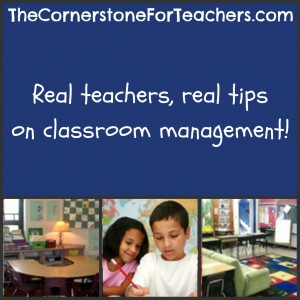
Today I’m introducing a new feature on The Cornerstone. Each month, I’ll be inviting one educator to share a few classroom management tips that have worked in his or her classroom. I’m hoping to feature a wide cross-section of teachers from all different parts of the world, at all different grade levels, in all different teaching scenarios. Want to be featured here? Just fill out the guest blog form!
July’s featured teacher is Tessa Maguire, who has served in a huge variety of school-based positions over the years, and currently serves as Primary Grades Team Leader. She spends her days in K-3 classrooms discovering what works and hearing the best stories. Thank you, Tessa, for sharing your perspective here!
Classroom Management. Behavior Management. Your What-The-Heck-Are-You-Doing Plan.

No matter what you call it, classroom management is crucial. We can dream about having 25 kids sit in their desks, listen, and do exactly what we ask of them. But, it’s not going to happen. In fact, I think it might make things a bit boring actually. *gasp* I mean, sometimes that kid who shouts out something so ridiculous that makes you all (including you) laugh, is a blessing in disguise because things need lightening up. But, none of us want that to happen all day long. No one would learn anything. So what do you do when you have 2 3 5 kiddos who don’t fit the mold? How do you keep it from being 12 kids who don’t fit the mold?
Expectations
Explicit expectations are key. I remember my very new self telling a fifth grader that he knew exactly how to behave and why didn’t he do it. Well, because he didn’t really know. I assumed, naively, that fifth graders just knew how to act in my class (I had them for 50 minutes but they belonged to other teachers). Students need to be shown, on Day 1, exactly what you want of them. If not, they spend so much energy trying to figure it out. You spend so much energy correcting and redirecting them. The first few weeks of school should be spent going over everything. You explain. You demonstrate. They demonstrate. You practice. If it doesn’t go correctly, you do it again. If it does, you PRAISE! If the students know exactly what you want, *most* do exactly what you are looking for *most* of the time.
Notice I said most. Most and all are not the same. Most kids will do what you have laid out- but not all. And even then, you have those kids who slip up. Those slip ups can be fixed with reminders and redirections most of the time. But, some students need a little more support for us. This usually comes in the form of a behavior plan of some sort.
Individual behavior plans
There are different schools of thought behind behavior plans. I don’t pretend to know all there is to know about behavior plans. I’ve implemented some very effective ones, and some others that were not as effective. Just this year I had a student that continued to push his limits and I had to continue to try different methods. With that said, I believe in plans that focus on positive reinforcement. I also don’t believe something can be taken away that a student has previously earned. For example, if a student gets tickets for following directions, I do not think it’s fair to take a ticket away if the student didn’t follow directions. It nulls their previously wanted behavior. They earn the ticket for following directions, and if they don’t, no ticket is earned. Behavior plans are also most effective when students can see that their reward is in sight. Plans should start out small and then build. It may be that students can possibly earn a reward at the end of the day. Then it builds to the end of the week. Then it builds to the end of two weeks. Or, after trying it out after a few weeks, you may decide you need to scrap it and start over.
What about rewards?
Rewards are another interesting topic with behavior plans. Some teachers use treasure chests that they fill with items from the dollar store. Some would prefer to use rewards that don’t need to be purchased. I believe that using non-monetary rewards, helps students build the intrinsic motivation they’d been previously lacking. Need some ideas for non-monetary rewards? Click on the pictures below to download two pages of ideas.
Tessa Maguire is a former reading teacher and differentiated instruction coach. She currently is in a dual role administration and curriculum coaching position. She spends her days helping her K-3 teachers find what works best for them and their students. She blogs about the resources she finds and creates and she shares tips and strategies for effective instruction. You can find out more information on her blog Tales from Outside the Classroom.


Angela Watson
Founder and Writer
Sign up to get new Truth for Teachers articles in your inbox
OR

Join our
community
of educators
If you are a teacher who is interested in contributing to the Truth for Teachers website, please click here for more information.


















